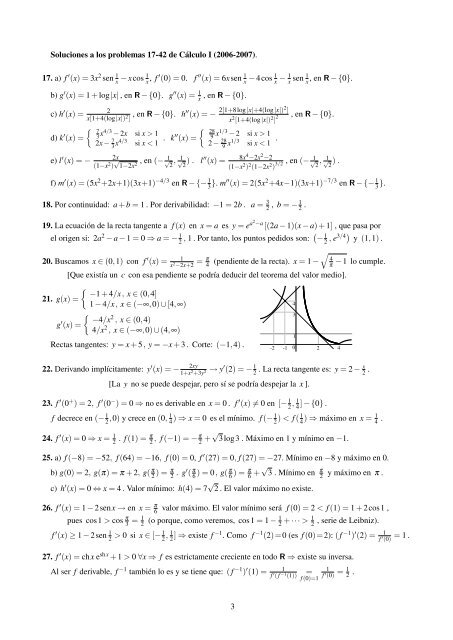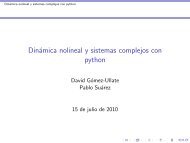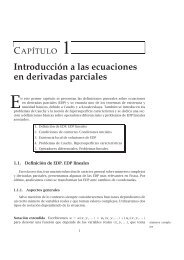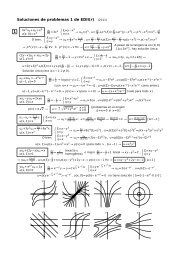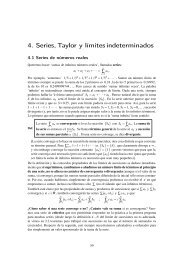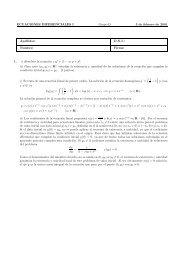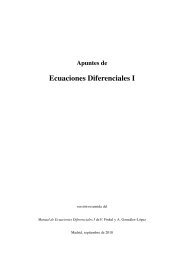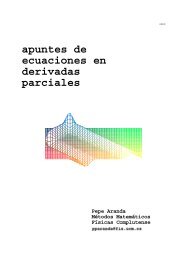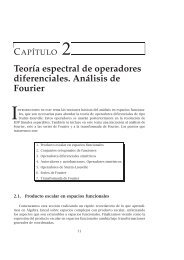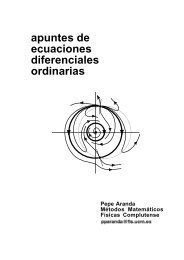1. a) Si x ⥠2, numerador y denominador son ⥠0 , si x < â2
1. a) Si x ⥠2, numerador y denominador son ⥠0 , si x < â2
1. a) Si x ⥠2, numerador y denominador son ⥠0 , si x < â2
- No tags were found...
You also want an ePaper? Increase the reach of your titles
YUMPU automatically turns print PDFs into web optimized ePapers that Google loves.
Soluciones a los problemas 17-42 de Cálculo I (2006-2007).17. a) f ′ (x) = 3x 2 sen 1 x − xcos 1 x , f ′ (0) = 0. f ′′ (x) = 6xsen 1 x − 4cos 1 x − 1 x sen 1 x, en R − {0}.b) g ′ (x) = 1+log|x| , en R − {0}. g ′′ (x) = 1 x, en R − {0}.c) h ′ 2(x) =x[1+4(log|x|) 2 ] , en R − {0}. h′′ (x) = − 2[1+8log|x|+4(log|x|)2 ]x 2 [1+4(log|x|) 2 ] 2 , en R − {0}.{ 73d) k ′ x(x) =4/3 {− 2x <strong>si</strong> x > 1282x − 7 3 x4/3 <strong>si</strong> x < 1 . k′′ (x) = 9x 1/3 − 2 <strong>si</strong> x > 12 − 28 9 x1/3 <strong>si</strong> x < 1 .e) l ′ (x) = −2x(1−x 2 ) √ , en (− √11−2x2 2, √ 1 2) . l ′′ 8x(x) =4 −2x 2 −2(1−x 2 ) 2 (1−2x 2 3/2, en (− √1) 2, √ 12) .f) m ′ (x) = (5x 2 +2x+1)(3x+1) −4/3 en R − {− 1 3 }. m′′ (x) = 2(5x 2 +4x−1)(3x+1) −7/3 en R − {− 1 3 }.18. Por continuidad: a+b = 1 . Por derivabilidad: −1 = 2b . a = 3 2 , b = − 1 2 .19. La ecuación de la recta tangente a f(x) en x = a es y = e a2 −a [(2a − 1)(x − a)+1] , que pasa porel origen <strong>si</strong>: 2a 2 − a − 1 = 0 ⇒ a = − 1 2 , 1 . Por tanto, los puntos pedidos <strong>son</strong>: ( − 1 2 , e3/4) y (1,1) .√20. Buscamos x ∈ (0,1) con f ′ 1(x) =x 2 −2x+2 = π 4(pendiente de la recta). x = 1 − 4π− 1 lo cumple.[Que existía un c con esa pendiente se podría deducir del teorema del valor medio].{ −1+4/x, x ∈ (0,4]2<strong>1.</strong> g(x) =1 − 4/x, x ∈ (−∞,0) ∪[4,∞){ −4/xg ′ (x) =2 , x ∈ (0,4)4/x 2 , x ∈ (−∞,0) ∪(4,∞)431Rectas tangentes: y = x+5, y = −x+3 . Corte: (−1,4) .-2 0 2 422. Derivando implícitamente: y ′ (x) = − 2xy1+x 2 +3y 2 → y ′ (2) = − 1 2 . La recta tangente es: y = 2 − x 2 .[La y no se puede despejar, pero sí se podría despejar la x ].23. f ′ (0 + ) = 2, f ′ (0 − ) = 0 ⇒ no es derivable en x = 0 . f ′ (x) ≠ 0 en [− 1 2 , 1 4 ] − {0} .f decrece en (− 1 2 ,0) y crece en (0, 1 4 ) ⇒ x = 0 es el mínimo. f(− 1 2 ) < f( 1 4 ) ⇒ máximo en x = 1 4 .24. f ′ (x) = 0 ⇒ x = 1 2 . f(1) = π 2 , f(−1) = − π 2 + √ 3log3 . Máximo en 1 y mínimo en −<strong>1.</strong>25. a) f(−8) = −52, f(64) = −16, f(0) = 0, f ′ (27) = 0, f(27) = −27. Mínimo en −8 y máximo en 0.b) g(0) = 2, g(π) = π + 2, g( π 2 ) = π 2 . g′ ( π 6 ) = 0, g( π 6 ) = π 6 + √ 3 . Mínimo en π 2c) h ′ (x) = 0 ⇔ x = 4 . Valor mínimo: h(4) = 7 √ 2 . El valor máximo no existe.-1y máximo en π .26. f ′ (x) = 1 − 2senx → en x = π 6valor máximo. El valor mínimo será f(0) = 2 < f(1) = 1+2cos1 ,pues cos1 > cos π 3 = 1 2 (o porque, como veremos, cos1 = 1 − 1 2 + ··· > 1 2, serie de Leibniz).f ′ (x) ≥ 1 − 2sen 1 2 > 0 <strong>si</strong> x ∈ [− 1 2 , 1 2 ] ⇒ existe f −1 . Como f −1 (2)=0 (es f(0)=2): ( f −1 ) ′ (2) = 1f ′ (0) = 1 .27. f ′ (x) = chx e shx + 1 > 0 ∀x ⇒ f es estrictamente creciente en todo R ⇒ existe su inversa.Al ser f derivable, f −1 también lo es y se tiene que: ( f −1 ) ′ (1) =1f ′ ( f −1 (1))=f(0)=11f ′ (0) = 1 2 .3


